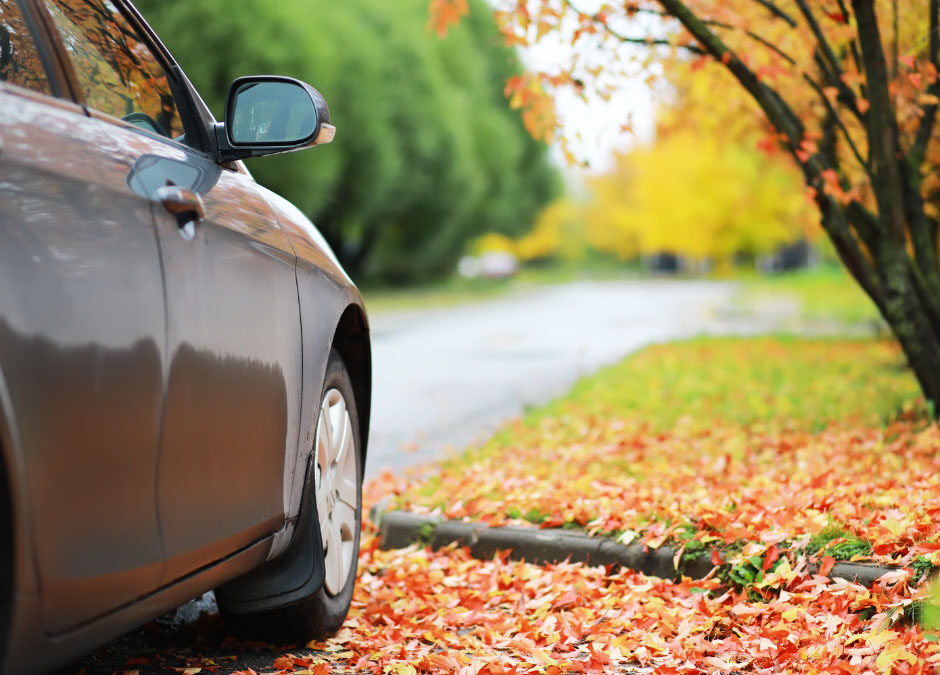As summer fades and autumn takes over, drivers face new challenges: earlier sunsets, wet roads, leaf-covered surfaces, and rapidly shifting weather. These changing conditions can increase risk—but with some foresight and adjustment, you can stay safe. Here’s a guide to driving smarter this fall.
Why Fall Drives Need Extra Care
- Shorter daylight hours – You’ll spend more time driving in dusk, dawn, or darkness. Vision isn’t as sharp; depth perception and contrast suffer.
- Wet surfaces & fallen leaves – Leaves, especially when wet, act like slick surfaces (sometimes similar to ice). Rain, frost, and melting dew can make roads deceptively slippery.
- Temperature swings – Nights get cold; mornings might bring frost or even black ice. Daytime warmth can mask hazards early and late in the day.
- Glare, fog, and visibility issues – Low sun angles, fog, rain, or moisture on windshields reduce visibility.
- Wildlife, school zones, and distracted drivers – Animals are more active, children are going to and from school often, and other drivers may not yet have adapted to fall hazards.
Prepare Your Vehicle
A well-maintained car can make a big difference. Here are things to check before—or early in—fall:
- Tires
- Check tread depth. Deeper tread helps channel water & improves grip.
- Maintain recommended tire pressure. Cold nights can lower pressure; under-inflated tires reduce traction.
- Brakes
- Ensure pads are in good shape, brakes respond smoothly. Slippery conditions make stopping distances longer, so solid brakes are essential.
- Lights and signals
- Verify all lights work: headlights (both low and high beams), taillights, turn signals, brake lights.
- Clean lenses of dirt or haze. Dirty or fogged lights lose effectiveness.
- Consider adjusting or aiming headlights properly if needed.
- Windshield, wipers & washers
- Replace worn wiper blades so they clear water, leaves, frost well.
- Keep washer fluid topped up; add antifreeze or spray-freeze-resistant fluid if needed.
- Clean windshield inside and out—smudges and streaks magnify glare.
- Defroster, heating & seals
- Make sure heating, defrosting, and window demisters work well.
- Check weather-stripping around doors and windows so moisture doesn’t leak in and fog up interior surfaces.
- Emergency supplies
- Keep a flashlight, blanket, gloves in case you have to stop or your vehicle breaks down in cold conditions.
- Consider having a small first-aid kit, ice scraper, and maybe extra windshield washer fluid.
Adjust Your Driving Habits
Even with a well-kept car, your habits matter. Here are driving behaviors to adopt in autumn:
- Slow down
- Give yourself more time to react; the stopping distance on slick roads or leaves is longer.
- Avoid sudden braking or sharp turns. Smooth, gradual movements help maintain traction.
- Increase following distance
- Leave more space between you and the car ahead. A standard following distance may not be enough when roads are slippery or visibility is low.
- Be extra alert at dawn, dusk, and night
- Use headlights earlier. Turn them on when needed (rain, fog, dusk).
- Watch for pedestrian traffic, children near buses, wildlife crossing roads.
- Manage glare
- Use sun visors, polarized sunglasses.
- Keep the windshield clean inside and outside. Even small smudges scatter light.
- If the sun is directly ahead, slow down or pull over safely until visibility improves.
- Drive defensively
- Expect hazards others might ignore: wet leaves, hidden potholes under leaf cover, black ice.
- Anticipate sudden weather changes. If it starts raining or fog sets in, reduce speed immediately.
- Be prepared that other drivers may misjudge conditions.
- Know what to do if you start slipping
- If you feel traction loss (skid or slide), don’t slam the brakes. Ease off the accelerator; steer gently toward the direction you want to go.
- Avoid overcorrecting. Minor adjustments are better than jerky steering.
- Choose safer routes if possible
- Routes that are well lit, less shaded (since shaded road areas stay wet longer or get icy sooner).
- Roads with less leaf accumulation.
- Avoid roads prone to flooding or with poor drainage.
Extra Tips for Specific Scenarios
- School zones & buses – Fall means children at bus stops. Drive slowly, be ready to stop when buses have flashing lights, and obey school speed limits.
- Wildlife – Dawn and dusk are peak times for animal activity. In forested or rural areas, slow down and scan the road edges. If you see one animal, more may follow.
- Fog & mist – Use low beams or fog lights if your car has them. High beams reflect back off moisture and reduce visibility. Pull over if visibility is dangerously low.
- Frost & ice – Overnight and early morning can bring frost, especially on bridges, overpasses, and shaded roads. Be extra cautious, even if the rest of the road looks dry.
Organizing Your Mind & Time
- Give yourself extra time for your commute so you’re not rushed—rushing typically leads to risky moves.
- Adjust routines: plan to avoid driving during the worst visibility times if possible (just after sunset, before sunrise).
- Check weather forecasts ahead. Rain, sleet, or frost can drastically change how safe driving is.
Final Thoughts
Driving in fall doesn’t have to be stressful. The season has its beauty, but it demands respect and preparation. With a properly maintained vehicle, adjusted driving habits, and extra mindfulness, you can handle shorter days and slick roads safely—and maybe even enjoy the ride more.




